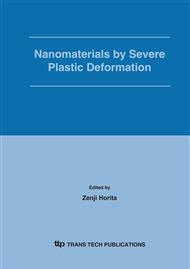p.433
p.439
p.447
p.455
p.461
p.469
p.475
p.481
p.487
Dissolution of Cementite in Carbon Steels by Heavy Deformation and Laser Heat Treatment
Abstract:
Dissolution behavior of cementite in eutectoid steels with pearlitic and spheroidite structures by severe plastic deformation was studied. Applying a long time milling, cementite dissolved completely and matrix turned out to be nanocrystalline ferrite. By a ball drop deformation (at high strain rates), heavily deformed layers in which cementite dissolves completely or partially were produced. By applying pulsed laser irradiation, re-austenitized zone which transformed to fresh martensite during quenching was produced. The boundary between the re-austenitized zone and matrix exhibited similar microstructure with that observed in specimens subjected to a ball drop deformation. It was suggested that the dissolution of cementite by heavy deformation at high strain rates are probably due to thermal effect, that is, re-austenitization.
Info:
Periodical:
Pages:
461-468
Citation:
Online since:
January 2006
Keywords:
Price:
Сopyright:
© 2006 Trans Tech Publications Ltd. All Rights Reserved
Share:
Citation:


